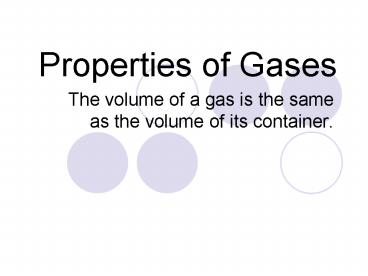Properties of Gases - PowerPoint PPT Presentation
1 / 35
Title:
Properties of Gases
Description:
Properties of Gases The volume of a gas is the same as the volume of its container. Properties of Gases The volume of a gas is the same as the volume of its container. – PowerPoint PPT presentation
Number of Views:52
Avg rating:3.0/5.0
Title: Properties of Gases
1
Properties of Gases
- The volume of a gas is the same as the volume of
its container.
2
Properties of Gases
- The volume of a gas is the same as the volume of
its container. - This is because gases fill the space available.
3
Measuring gas temperature
- Temperature is a measure of the energy of motion
of the particles.
4
Measuring gas temperature
- Temperature is a measure of the energy of motion
of the particles. - The faster the particles move, the greater the
energy and higher the temperature.
5
A thermometer
- is like a speedometer for molecules.
6
How fast do gas particles travel?
7
How fast do gas particles travel?
- About 500 meters/second at room temperature.
8
How fast do gas particles travel?
- About 500 meters/second at room temperature.
- They collide constantly with each other and the
walls of their container.
9
The outward push is called pressure.
10
The outward push is called pressure.
- Pressure Force/Area
11
The outward push is called pressure.
- Pressure Force/Area
- The USA measures pressure as PSI
12
The outward push is called pressure.
- Pressure Force/Area
- The USA measures pressure as PSI (pounds per
square inch).
13
The outward push is called pressure.
- Pressure Force/Area
- The USA measures pressure as PSI (pounds per
square inch). - The SI measure is kPa (kilopascals).
14
In an inflated ball,
- there are more particles inside than outside.
15
In an inflated ball,
- there are more particles inside than outside, so
the pressure inside is greater.
16
Your chance for fame fortune!
- If you increased the pressure on the outside of
the ball, would the ball change in volume?
17
If you said
- the ball would get smaller . . .
18
You could have been famous!
If you said
- the ball would get smaller . . .
19
Boyles Law
This is called
- When the gas pressure increases, the volume
decreases. - When the pressure decreases, the volume
increases.
20
Boyles Law
Least pressure
Most pressure
Most volume
Least volume
21
A second chance at fame . .
- If you put a balloon in the refrigerator, would
it stay the same size, increase in size, or
decrease in size?
22
And the answer is . . .
- It would decrease in size?
23
Charless Law
This is called
- When the temperature of a gas is increased, its
volume increases. - When the temperature decreases, volume decreases.
24
Charless Law
Low temperature
High temperature
Low volume
High volume
25
Charless Law
Low temperature
High temperature
Low volume
High volume
If you double the temperature, you also double
the volume.
26
Relationship between pressure and temperature.
Low pressure
High pressure
Low temperature (slow particle movement)
High temperature (fast particle movement)
27
Which box below would have the least mass, A or
B?
Low pressure
High pressure
Low temperature A
High temperature B
28
The answer is NEITHER. The mass would be the
same! WHY?
Low pressure
High pressure
Low temperature A
High temperature B
29
The amount of matter is unchanged.
Low pressure
High pressure
Low temperature A
High temperature B
30
But Ive always heard that hot air rises, so
wouldnt B be lighter?
Low pressure
High pressure
Low temperature A
High temperature B
31
It would be more accurate to say that less dense
air rises.
Low pressure
High pressure
Low temperature A
High temperature B
32
And the density of A and B is the same.
Low pressure
High pressure
Low temperature A
High temperature B
33
So how could you make box B gas less dense than A?
Low pressure
High pressure
Low temperature A
High temperature B
34
When you figure that out, youll know the real
secret behind why a hot air balloon floats!
Low pressure
High pressure
Low temperature
High temperature
35
(No Transcript)































